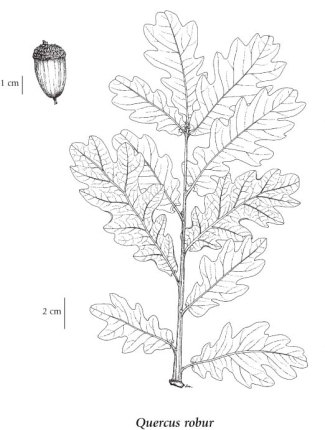English oak
Fagaceae (Beech family)
Introduction to Vascular Plants
Introduction
English Oak is an introduced European species in North America, where it is widely cultivated. It is reported from several US states ((MA, ME, NH, NY, OH, PA, RI), and five Canadian provinces (BC, NB, NS, ON, PE) (USDA 2010). While it is widely grown, it is naturalized only in Washington, New Brunswick and Nova Scotia (Flora North America Online 2010). In British Columbia, it is also naturalized,and is frequently encountered in the southwestern corner of the province, where it persists in areas where acorns have been introduced as squirrel food, or where it has been planted. It is often encountered as seedlings or young saplings under a forest canopy in drier sites near urban areas, particularly in areas of peat soil. Wild plants have been collected by Lomer in Squamish and on Sumas Mountain and it is frequent in drier parts of the Lulu Island Bog in Richmond.
Taxonomically, this is a tree species of oak in the white oak group (Quercus section Quercus). It most closely resembles the eastern North America white oak (Quercus alba). In British Columbia, it resembles Garry oak (Quercus garryana), but may be separated based on leaf lobing, leaf petiole length, and acorns. It reaches heights of 30 m and has shallowly lobed leaves with leaf stalks 1-3 mm in length. Fruits (acorns) occur on long stalks. |
Species Information
General:
Deciduous spreading tree up to 30 m tall; bark light grey with thick scaly ridges.
Leaves:
Alternate, deciduous, blades oblong to egg-shaped in outline, shallowly lobed with stalks 1-3 mm long, the largest sinuses extending much less than halfway to the midrib, dark green and glabrous above, paler below, turning yellowish-brown in the fall.
Flowers:
Inflorescence of tiny inconspicuous male and female flowers separate but on the same tree; female flowers clustered or single surrounded by a scaly cup-like involucre, male flowers numerous in catkins.
Fruits:
Acorns, 1-seeded, maturing in one season, on long stalks, egg-shaped to nearly round, 2-3 cm long; cups shallow, bumpy.
Illustration

If more than one illustration is available for a species (e.g., separate illustrations were provided for two subspecies) then links to the separate images will be provided below. Note that individual subspecies or varietal illustrations are not always available.
Illustration Source: The Illustrated Flora of British Columbia
Habitat and Range
Mesic forest edges and open fields near habitation in the lowland zone; rare in SW BC; introduced from Europe.Status Information
Synonyms
Synonyms and Alternate Names:
Quercus robur (Lam.) O. Schwarz
Similar Species
In British Columbia, English oak is most easily confused with the native Garry oak (Quercus garryanna). The two species may be separated by characteristics of leaf lobing, leaf stalks, and acorn morphology. In English oak, leaf lobing is shallow, less than halfway to the midrib, while in Garry oak lobing often extends more than halfway to the midrib. Leaf petioles in English oak are 1-3 mm long, while in Garry oak they are 1-2 cm long. English oak acorns have relatively long stalks, while Garry oak acorns are stalkless. Identification in oaks can be challenging because of the frequency of hybridization.
|